|
|||||
Channel CatfishOur first fish choice was channel catfish which turns out to have been a very good choice for outdoor aquaponics here in central Florida. Channel catfish can take the heat just as well as tilapia yet they can also handle the cold and will even keep growing well below the 70 degree F water temp that usually slows tilapia down. So in a non tropical and non climate controlled situation, catfish are likely to grow just as fast if not faster than tilapia. Since flood and drain aquaponics tends to bring the water temperatures closer to air temperatures faster, having fish that can handle the warm and cool extremes can be a benefit. Channel Catfish certainly fall into this category. Only a couple points about catfish make them slightly less hardy than tilapia; their need for slightly better aeration/water quality and their dislike of excessive handling. They are still rather hardy fish and completely reasonable for Aquaponics. Channel Catfish are also native to the eastern United States. Channel Catfish is one of the most farmed fish and much research has been done in the field of catfish feed. This makes finding commercial feed for them quite easy and is a big topic for Aquaponics. I’ve mostly fed Aquapmax 4000 feed to both my Channel Catfish and tilapia and that feed seems to provide good nutrient levels for the Aquaponics System and plants. I am still in search of alternative foods but haven’t found better yet. Catfish have a good feed conversion ratio (this means much of the food given is turned into meat rather than wasted.) Channel Catfish have the benefit of getting BIG and this can mean less work to clean them to make a meal wen one fish will feed the whole family instead of having to clean lots of smaller fish. Aquaponic Catfish taste good and we have never experienced a “muddy” flavor from any of our Aquaponic fish. Can’t get much fresher than eating the fish only yards and hours from where and when it was caught. 25 comments to Channel CatfishLeave a Reply |
|||||

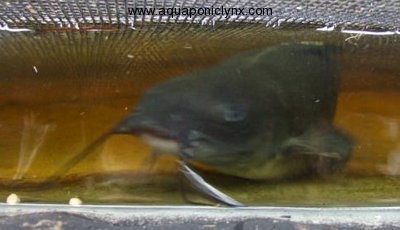
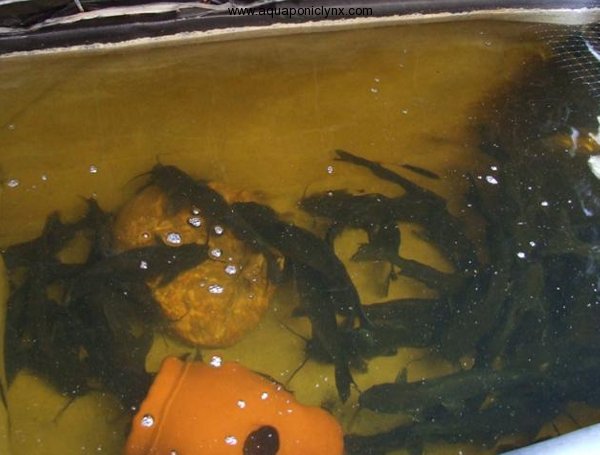
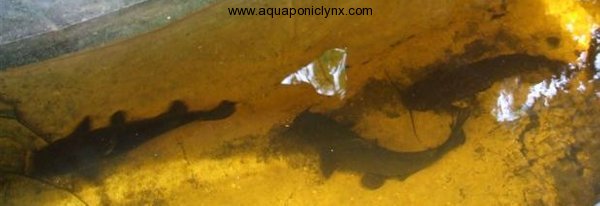
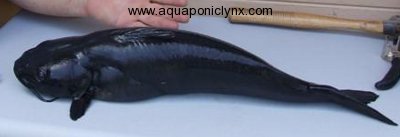
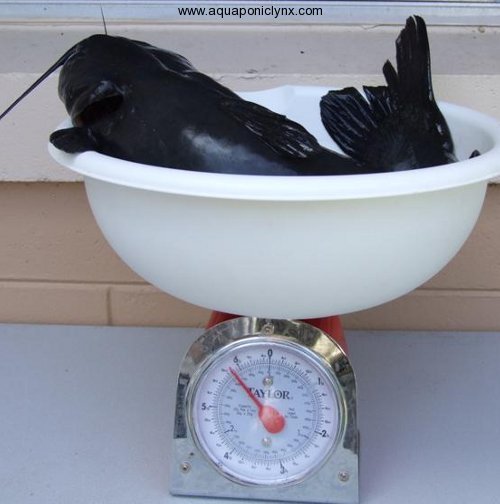
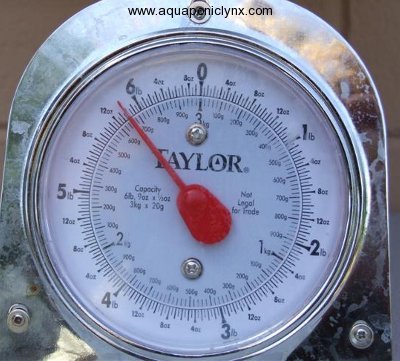


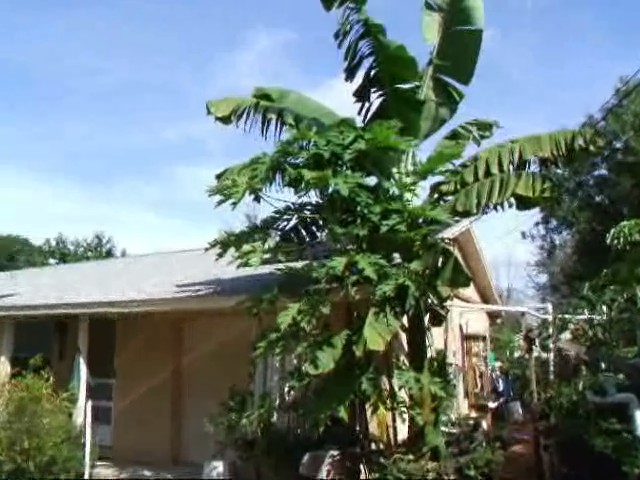
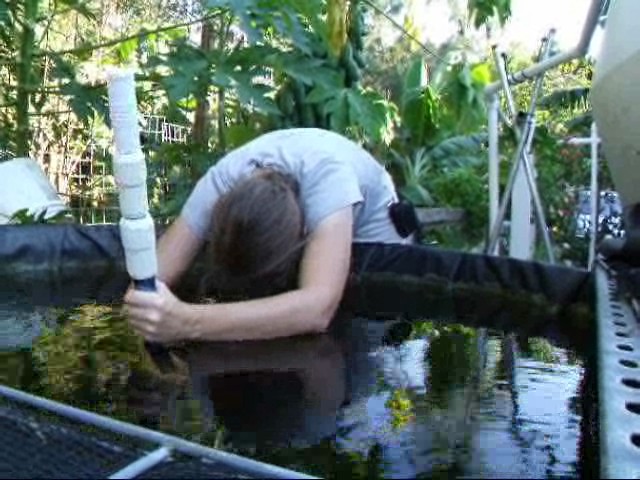
They co-culture well with middle- or top-dwelling fish. The only issue I have had with goldfish cohabitation, is that the goldfish are getting obese on the catfish fingerling food (local brand Lone Star Fingerling Pellets) while the cats are growing more proportionately.
I think they are the cutest thing swimming. I may say otherwise after I get poked by a fin though, I recall that’s quite painful!
This is lovely
what is the recommended stocking density for catfish (fingerlings and adults) for a 250 gallon tank?
Stocking needs to be based on the filtration, without knowing what the filtration is, I can’t recommend stocking any fish in a tank.
For a Flood and drain media bed aquaponics system. For grow out I will stock one channel catfish per 20 gallons of grow bed with 10 gallons of fish tank per fish. Such a system would need some form of sump tank or sequencing valve to control water level fluctuation.
I personally prefer fish tanks of at least 300 gallons for growing out channel catfish.
I have built a raft system with a three hundred gallon tank and around 400 gallons in the grow beds. We are cycling for the first time. We can’t get the nitrites down. On the dip strip they are maxed out. Ammonia is around 1 and nitrates are around 20. Can you help? We have drained system water down 200 gallons or so at least 4 time in the last week. It hasn’t helped.
Steve,
How long have you been cycling? Cycling up a new system normally takes about 6 weeks, doing water changes often only lengthens the process but if you have fish in the system it is sometimes the only way to save them.
Do you have the rafts on the beds? Is the Water you are topping up with non chlorinated?
Are you fishless cycling or are there fish in the system? If fish, how many, what size, what type?
What are your water temperatures? What is the pH? How much aeration do you have running? How much water are you pumping around the system each hour? How many square feet are the grow beds? Do you have any additional filtration?
Can anyone tell me what is ideal ph and nitrate level for 300 gal system with catfish? 150 fingerlins in 300 gal tank and keep losing some each day. We are thinking we have too many fish? Have lowered the 7 air stones to bottom thinking that was problem. Have 2 4 x 8 grow beds. System up only 3 wks now but hate to loose ALL my fish here.
I don’t think there is really a good answer for “Ideal pH and nitrate level for a 300 gallon fish tank with catfish”
Catfish seem to do pretty well in a pH range between 6-8 in my experience and nitrates are generally not what is toxic to fish in an aquaponics system, so as long as your nitrates are below say 500, I wouldn’t worry too much about them.
It is the ammonia and nitrite that are probably killing your fish.
Sorry Marry but you are right, you have WAY to many fish for a brand new system. Channel catfish are sensitive to bad ammonia spikes and poor water quality that can often happen in a brand new system, let alone one that has probably well over 3 times as many fish as it should.
Are those 4×8 grow beds media filled grow beds? If so I would estimate that you might support growing out about 32 channel catfish in that system to 1 1/2-2 lb each. (I don’t care if the fish are tiny at the moment, your system isn’t cycled up yet so you should start with tiny fish and only as many of them as you could grow out so the system could cycle up to the load as the fish grow.)
If they are raft beds, do you have any additional filtration? If you are doing a friendly style raft system, I would say you probably shouldn’t grow out more than 10-15 channel catfish in that system.
While the fish are small that system might be able to support more fish but only after it is cycled up. You say you are at 3 weeks, that is normally when the ammonia and nitrite spikes are the worst and it is probably the ammonia and nitrite levels that are killing your fish, not the pH or nitrate.
What do you water tests say.
Temperature
pH
Ammonia
Nitrite
Nitrate
An aquaponics system needs to cycle up (that means have the bio-filter bacteria colonize the system) before it can handle many fish. Cycling up a system usually takes around 6 weeks under good conditions.
cycling up a new system with fish
Aquaponics Fishless cycling
There are some links to blog posts about cycling up a new system.
Channel catfish can handle a fairly wide range of pH (6-9) (the bacteria like a pH of between 7.4-8 and the plants would prefer a pH of around 6 the test kit I have only measures down to 6 so I make sure to keep the pH enough above 6 that I can be sure it isn’t way lower. pH will naturally drop over time so you regularly need to bring it back up but do so carefully since changing it more than about 0.2 per day can hurt your fish, plants and bacteria.) A higher pH is better for getting the bacteria to colonize but if the pH is too high and the ammonia high it makes the ammonia more toxic and tends to kill the fish faster.
Unfortunately at this point the only likely way for you to save fish is to probably get rid of most of them and do lots of water changes to bring the ammonia and nitrite levels back down. Unfortunately if you already have fish dieing, it could be too late and even if you suddenly put them all into prefect water, they may already be weak and have only a limited recovery rate.
You seem to have a good handle on this whole thing and I have enjoyed reading your comments. I have an existing koi pond that is 5500 gal. it has about 25 18 inch koi and 100 or so gold fish, I was thinking about using my pump and filter system to do the grow beds ,I havent checked the ph for years they have been very happy and multiplying. what are the chances I will hurt my pond by adding grow beds in the system?
Well, I don’t see that adding grow beds to the system would “HURT” your existing pond, However, if your pond is already well balanced (with filtration and pond plants to use up the nutrients so that you don’t need to do water changes) you may not have a whole lot of extra nutrients available to feed the plants in grow beds.
To figure out if you have enough nutrients to support grow beds, you might want to get a test kit and check for nitrates and/or phosphorus. If you are having to do water changes to keep nitrates and/or phosphorus in check, then you might be able to add grow beds and switch over to just topping up water instead of needing to do water changes. You will probably need to start keeping an eye on pH as well if you do stop doing water changes.
I flush my filters every day and loose about 30 gal of water doing that but other than misters going on the surface for aeration and to replace the the water I use flushing , I dont do water changes.But koi like murky water for breeding. I will get a test kit and do as you suggest.My water falls have bio filters and I use barley straw in those , every time I change the straw (3 times a year)its full of worms and the fish love those, so do the chickens.what ph is good for catfish ? and can I raise them with the koi?
I expect Koi and catfish can co-exist. I had some goldfish, koi, catfish and bluegill all living together in the same system for a while. Biggest problem I have with trying to keep different types of fish together is what to do when trying to harvest all of a particular variety might be hard on the fish you are not trying to harvest. big Catfish and Koi will be slower moving and therefor tend to get hurt if you are swinging a net trying to catch the bluegill.
pH, between 6-8 is likely fine for the catfish. It is your plants that will be pickier about pH since the plants like a lower pH.
New to Aquaponics.
Hi, thanks so much for the advice.
I have taken an IBC tote, cut it so there is a 12 inch grow bed, and I have two sump pumps circulating water between the two tanks.
I have also cut out a raft bed and have it floating already.
We are looking to grow lettuce and basil in our raft beds. We will use Channel Catfish in our tank.
What do we do next?
So new to this, and just a couple of high schoolers trying to figure it out. Need help.
Just to make sure you have enough filtration for your fish, only stock as many fish as you have cubic feet of gravel. Now that recommendation is for fish that only grow out to about 1 lb, if you intend to grow your catfish larger, reduce the number of fish you stock in the system.
Thanks for the help. Coming along smoothly
Any recommendations for an oxygen pump. One that isn’t too expensive preferably.
Uh, only that you probably don’t want a pure oxygen pump since that will be pretty expensive and if you don’t know what you are doing using pure oxygen, it is a rather expensive and possibly dangerous way to kill fish. I can’t make any recommendations for oxygen equipment since I haven’t used any myself.
You simply want an air pump or blower that uses AIR to aerate the water. I can’t really make any specific equipment recommendations without knowing the specifics of things like tank depth, total tank volume and purpose of the aeration.
You want 1 cubic foot per minute of air for every 400 gallons of fish tank water and the pump has to be able to deliver that at the depths (pressures) you need. For raft beds you need 1/2 cfm for every square meter of raft bed.
My system is still in the “what if” stage. I will be doing mostly a vertical system with a few flat flood and drain beds. I know I will have a 45 gallon sump tank with a 5 gallon biofilter as a final stage before pumping bank to a 250 gallon tote.
I am looking for a fish for food that will reproduce in the tank that is legal for home growers in NW Florida. I dont think Tilapia will do well here in the winter and have read that channel cats will not reproduce. Do you have any suggestions.
Thanks,
Mike
In a system that size, I don’t think you want to mess with trying to get the fish to reproduce. Channel catfish don’t mature till at least 3-5 years of age so you probably don’t want to mess with them for breeding, though they are a good fish to eat and you can probably get fingerlings each year pretty easily. An IBC system is on the small side for channel catfish though since they can get so big within a year.
Blue gills or sunfish or any type of Brim may be a good choice to grow in your location and in a tote size fish tank (just make sure you take steps to avoid extreme temperature swings.) I’m not sure if you can breed them in such a system, I’ve not tried since it is usually easy to get fingerlings if you do it at the right time of year.
On a system design note…
That is a rather small system and if relying heavily on towers in NW Florida (if this is outdoors) you are likely to have issues with temperature swings so consider what you intend to do to mitigate that. I had problems with a tower/tote fish tank system when winter afternoon temps were warm but then we had an overnight freeze and the water temp went from over 65 F to 34 F by morning and the fish barely survived that rapid change. In the panhandle you would probably have to spend money heating water that was being chilled by towers outdoors during winter and even then you might have a difficult time keeping it warm enough for the fish to eat.
A 45 gallon sump tank is probably the bare minimum to handle just the towers and water moving through the system. If you want any flood and drain beds you will need a much bigger sump tank (for sump tank sizing with flood and drain beds, I recommend the sump tank be about 50-60% of the size of all the flood and drain beds combined.) So if you have 100 gallons of flood and drain beds, you need 50-60 gallons of sump tank.
However, for system stability (temperature and chemistry wise) you might simply get a second tote to use as the sump tank which will give you more total water volume and sump capacity to handle system expansion as well.
We have someone looking to start an aquaponics system using channel catfish. They have a 450 gallon tank with a sloping conical shaped floor that leads to a drain for easy cleanout. Would channel catfish do better on a flat bottomed tank and do they require some sort of substrate such as gravel? Thanks in advance.
Bill
Hello, I am starting a small aquaponics set up w/ a ~200gallon Inc tote, how many catfish should I be using?
The number of fish really depends more on the amount of filtration your system has. My feeling is that a 200 gallon tote as a fish tank is on the small side for channel catfish though, I prefer at least 300 gallons of fish tank for channel catfish. For each channel catfish I stock, I like to have at least 10 gallons worth of fish tank with a stable water level and 20 gallons worth of flood and drain grow bed per fish. Channel catfish can grow rather big pretty fast under good conditions. AND you can always start with less fish since a new system is usually not up to a full load even if you have done fishless cycling.
I’m looking for some advice in the form of educated guesses as I start an experiment. I have a 1/2 acre beaver pond and I stocked it late Spring(2019) and then then late Autumn(2019) with catfish, bluegill, bass, and fathead minnows. I also got to watch Blue Heron fishing that beaver pond. I also have a low flow stream(not associated with the beaver pond) that has never stopped flowing in summer or winter. I’d like to use a hydraulic ram pump to feed constantly feed untreated stream water to several 275 to 300 gallon IBC totes and raise some or all of those fish mentioned. The tanks would be located near the stream but above the flood zone. The area would received dabbled light from the tree canopy although I could put a tarp overhead for shade. The tanks would be in ambient temperature and I live in Central Virginia. I can set up a solar powered aeration system if the stream isn’t naturally aerated enough naturally. The stream is fed by my next door neighbors artificially dammed 3 acre pond so I think it should support fish.
I’d have to feed the fish. Any ideas on what to feed and how often? Any other advice you can give for something like this so that I just don’t kill off the fish. I don’t think having fish breed in this situation is feasible. But raising them so that I don’t lose them to predators and I can get a steady supply of fish would be nice. Thanks
You might want to start off by doing some water testing and reading/learning about keeping fish. I don’t know how much elevation you have to run a ram pump and I don’t know how much flow you would get from that. I don’t personally have any experience running a flow through fish farm so I don’t know what the flow through and stocking rates and aeration needed to keep fish alive/healthy are. I know recirculating aquaponics so I am probably not the best person to answer your questions. You are going to want to research aquaculture and you will need to check the legality of doing a flow through design in your state to see what the requirements are for cleaning up the discharge water before dumping it back in the stream.
Amount you can feed is largely dependent on your capacity to keep the water clean. In aquaponics or recirculating aquaculture that is largely dependent on the filtration capacity of the systems. Fish in small tanks are going to experience more extreme temperature fluctuations than in large in ground ponds so that will be something to take into account. I’m not sure that a solar aeration system is going to be enough without considerable battery backup since if you need additional aeration, you would need it 24/7 and not just when the sun shines.
There is a heck of a lot of variables that you will want to research in your plan, this isn’t something easy to answer in one post.
Lately I’ve been getting my fish feed from Optimal Fish Feed.
What is the fcr for catfish? Is your reccomended stocking density of 10 gallons fish tank for a 1 Lb catfish?
As long as you have enough filtration for the amount of fish/fish feed. Then My recommendation is that you stock one catfish per 10 gallons of fish tank water. That catfish can easily get over 1 lb but once you have catfish getting into the 1-2 pound range, you are usually starting to harvest fish so that by the time you have fish getting over 3 pounds there are fewer fish in the tank.
This method allowed me to stock 100 catfish into a 1000 gallon tank as fingerlings and as they grow I could harvest a few at a time so that things would not get too overloaded. Make sure there is ample water flow and aeration to keep the water quality good and make sure the filtration is removing the Ammonia and nitrite and your fish will stay healthy.